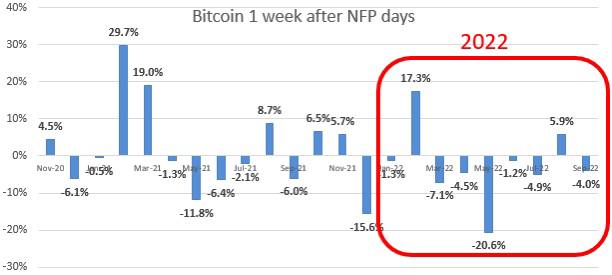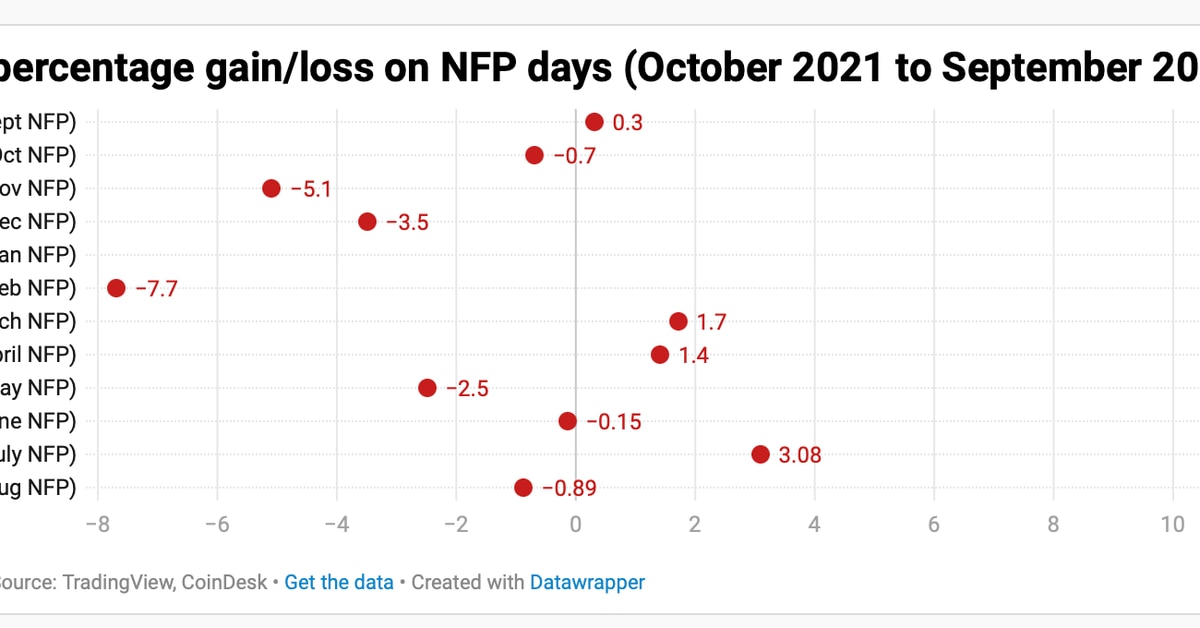Traders love volatility, which has recently gone missing from the bitcoin (BTC) market.
The leading cryptocurrency by market value has been locked in the narrow range of $18,000 to $20,500, barring a brief spike above $22,000 around mid-September, according to CoinDesk data.
The question is whether the market will come unglued immediately after the release of the U.S. nonfarm payrolls (NFP) data – the monthly jobs report – later on Friday. The data will reveal how much of the Federal Reserve’s liquidity tightening has affected the labor market and whether the central bank can afford to slow rate hikes in the coming months. The Fed tightening has roiled risk assets, including cryptocurrencies this year.
Past data suggests the payrolls figure affects the bitcoin market with a lag. In other words, the cryptocurrency could very well end the day within the recent range, only to see volatility pick up over the coming week.
The featured image shows that bitcoin has seen less than 5% percent price moves in nine out of the past 12 NFP days. The annualized returns on the past 12 NFP days have been 91%. That’s within the 365-day implied volatility 12-month range of 70% to 95%, according to data sourced from Laevitas.
The annualized returns are arrived at by calculating the standard deviation of BTC’s performance on the past 12 NFP days and then multiplying the same by the square root of 365. The implied volatility refers to investors’ expectations for price turbulence.
“Bitcoin has returned exactly 0.0%, on average, on NFP days in 2022. So, traders might conclude that NFP days are non-events,” Markus Thielen, head of research and strategy at crypto services provider Matrixport, said. “However, traders should be careful as the picture changes one week later.”

Bitcoin tends to be more volatile during the week after the payrolls release. (Markus Thielen/Matrixport) (Markus Thielen)
The chart shows bitcoin has declined in the week after the NFP seven out of nine times this year, producing an average return of -2.2%. That’s in stark contrast to 2021, when bitcoin chalked up an average return of 2.3% in the week after NFP.
“Based on history, today – when the employment data is released – matters less than how prices tend to react one week later…. Crypto traders should watch out…,” Thielen noted.
History could repeat itself, with bitcoin seeing increased downside volatility in the next seven days if the September payrolls figure blows past expectations. That would force markets to price out hopes of the so-called Fed pivot in favor of slower liquidity withdrawal.
The tighter the labor market, the stickier the inflation and the less room the Fed has to slow tightening. Expectations are for 250,000 job additions following the 315,000 increase in August.
Analysts at ING expect markets to drift away from the Fed pivot speculation following the payrolls data.
“Investors will look for any hint that the jobs market is starting to turn. We think it’s too early for that, and our economists are in line with consensus in expecting the unemployment rate to stay at 3.7% with payrolls slowing but staying above 200k (consensus 250k),” ING’s FX Strategist Francesco Pesole said in a note to clients.
“DXY [dollar index] could find its way back into the 113.00-114.00 region,” Pesole added. The greenback is one of the biggest nemeses of bitcoin.







